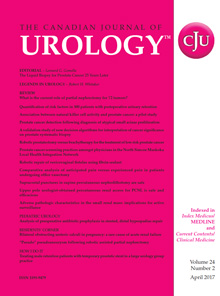 Indexed in Index Medicus and Medline
Indexed in Index Medicus and Medline
HOW I DO IT
-
How I Do It: Holmium laser cystolitholapaxy and enucleation of the prostate for benign prostatic hyperplasia
Gao M. Bruce, Saadat Seyedamirvala, Choi J. H. Edward, Jiang James, Das K. Akhil Department of Urology, University of California, Irvine, Orange, California, USA
Holmium enucleation of the prostate (HoLEP) is a gold-standard, size-independent surgical treatment for benign prostatic hyperplasia (BPH) distinguished for its efficacy in tissue removal, shorter catheterization durations, lower transfusion rates, and decreased hospital stays when compared to transurethral resection of the prostate (TURP). The objective of this article is to demonstrate the step-by-step procedure of holmium laser cystolitholapaxy and enucleation of the prostate for BPH, emphasizing a top-down modified two-lobe technique with early apical release which enhances visualization and irrigation flow during the enucleation process.
Keywords: prostate, BPH, HoLEP, cystolitholapaxy, holmium,
Jun 2024 (Vol. 31, Issue 3 , Page 11904)PDF (255.3KB)Free -
Use of the Schelin Catheter for transurethral intraprostatic anesthesia prior to Rezūm treatment
Hamouda Aalya, Ibrahim Ahmed, Corsi Nicholas, Siena Giampaolo, Elterman S. Dean, Chughtai Bilal, Bhojani Naeem, Sessa Francesco, Rivetti Anna, Secco Silvia, Zorn C. Kevin Faculty of Medicine and Health Sciences, McGill University, Montreal, Quebec, Canada
Minimally invasive surgery techniques (MIST) have become newly adopted in urological care. Given this, new analgesic techniques are important in optimizing patient outcomes and resource management. Rezūm treatment (RT) for BPH has emerged as a new MIST with excellent patient outcomes, including improving quality of life (QoL) and International Prostate Symptom Scores (IPSSs), while also preserving sexual function. Currently, the standard analgesic approach for RT involves a peri-prostatic nerve block (PNB) using a transrectal ultrasound (TRUS) or systemic sedation anesthesia. The TRUS approach is invasive, uncomfortable, and holds a risk of infection. Additionally, alternative methods such as, inhaled methoxyflurane (Penthrox), nitric oxide, general anesthesia, as well as intravenous (IV) sedation pose safety risks or mandate the presence of an anesthesiology team. Transurethral intraprostatic anesthesia (TUIA) using the Schelin Catheter (ProstaLund, Lund, Sweden) (SC) provides a new, non-invasive, and efficient technique for out-patient, office based Rezūm procedures. Through local administration of an analgesic around the prostate base, the SC has been shown to reduce pain, procedure times, and bleeding during MISTs. Herein, we evaluated the analgesic efficacy of TUIA via the SC in a cohort of 10 patients undergoing in-patient RT for BPH.
Keywords: BPH, Rezum, TRUS, PNB, Schelin Catheter, TUIA,
Feb 2024 (Vol. 31, Issue 1 , Page 11802)PDF (129KB)Free -
How I Do It: Optilume BPH catheter system
Elterman S. Dean, Gao Bruce, Zorn C. Kevin, Bhojani Naeem, Te Alexis, Chughtai Bilal, Kaplan A. Steven Division of Urology, Department of Surgery, University of Toronto, Ontario, Canada
Benign prostatic hyperplasia (BPH) is a common and progressive disease affecting aging men which has a significant impact on quality of life. The Optilume BPH Catheter System (Optilume BPH) is a prostatic dilation system that combines balloon dilation with a localized transfer of paclitaxel to maintain long term patency. Optilume BPH can be deployed using standard rigid cystoscopy without general anesthesia in an office setting. Prospective data indicate that Optilume BPH has favorable functional and sexual patient outcomes. Readers will familiarize themselves with Optilume BPH, significant historical studies and the technique for deploying Optilume BPH.
Keywords: prostate, BPH, MIST, Optilume,
Jun 2023 (Vol. 30, Issue 3 , Page 11568)PDF (396.1KB)Free -
How I Do It: The prostatic urethral lift for obstructive median lobes
Ashley S. Matt, Phillips Jason, Eure Gregg Summit Health, Bend, Oregon, USA
Millions of men in North America suffering from lower urinary tract symptoms (LUTS) secondary to benign prostatic hyperplasia (BPH) are managed on medical therapy. Most patients, however, report poor adherence, and yet relatively few pursue more definitive surgical solutions. The Prostatic Urethral Lift (PUL) was designed to address many of the patient-identified barriers to surgery, namely iatrogenic sexual dysfunction, incontinence, lengthy recovery and postoperative catheterization. Randomized studies and large real world multicenter and database studies have demonstrated safety and effectiveness of PUL when addressing lateral lobe disease. In recent years further technique and device development has led to the FDA approval for PUL addressing obstructive median lobes as well. At 12 months, PUL median lobe patients in a controlled trial and a large retrospective study experienced average IPSS improvement of 13.5 and 11.6 points, QoL improvement of 3.0 and 2.1 points, and Qmax improvement of 6.4 and 7.1 mL/sec, respectively. In the controlled setting, both ejaculatory and erectile function were preserved and postoperative catheterization rates, while higher than lateral lobe PUL rates, were similarly short lived with a mean duration of 1.2 days. We describe the current technique for performing PUL to address the obstructive median lobe and detail a new device, which can make it easier to alleviate obstruction due to trilobar anatomy.
Keywords: prostatic urethral lift, UroLift, benign prostatic hyperplasia, prostate, LUTS, BPH, PUL, middle lobe, median lobe,
Apr 2023 (Vol. 30, Issue 2 , Page 11509)PDF (660.5KB)Free -
How I do it: Aquablation in very large prostates (> 150 mL)
Helfand T. Brian, Kasraeian Ali, Sterious Steve, Glaser P. Alexander, Talaty Pooja, Alcantara Miguel, Alcantara Mola Kaitlyn, Higgins Andrew, Ghiraldi Eric, Elterman S. Dean Department of Surgery, NorthShore University Health System, Evanston, Illinois, USA
Aquablation has been well-studied in prostates sizes up to 150 mL. Recently, American Urological Association guidelines distinguish surgical interventions for men with large prostates (80 mL-150 mL) and now very large prostates (> 150 mL). Readers will gain an understanding of how to use Aquablation in the very large prostate size category.
Keywords: robotics, LUTS, BPH, aquablation, prostate surgery, urology,
Apr 2022 (Vol. 29, Issue 2 , Page 11111)PDF (1.97MB)Free




